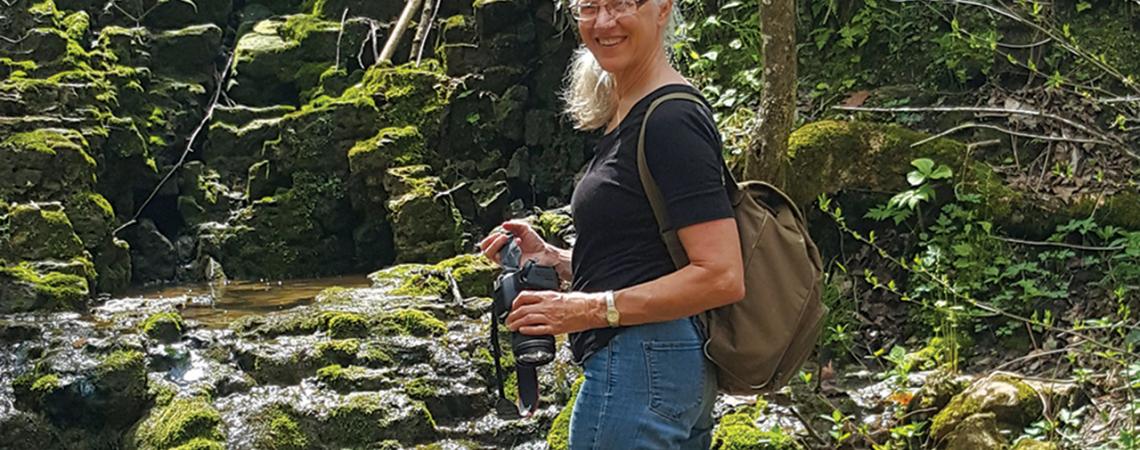Nancy Stranahan, co-founder and director of Arc of Appalachia, cultivates a statewide citizen advocacy network to support the purchase and, therefore, preservation of natural areas around the state.
Ask Nancy Stranahan, “What’s the point of preserving plain old woods?” and you’re certain to get an earful.
“I’d say guilty as charged, except for the word ‘plain,'” Stranahan says, explaining that southern Ohio’s hardwood forests are the last best chance to save an ecosystem that has one of the highest levels of biodiversity in the world. “The fact that 100,000 multicellular native organisms are at stake takes ‘plain’ out of the discussion.”
By the way, they’re not “woods,” either, as Stranahan also points out — call them “eastern deciduous forest.” Her more important point, though: Whatever you call them, they’re a mighty precious commodity. Because of that, she’s been latching onto and saving them, acre by acre, for more than two decades since founding Arc of Appalachia in 1995.
Arc of Appalachia’s land holdings are ever-expanding as the group, mostly volunteers, works to acquire crucial parcels, with all the stunning views, massive old-growth trees, and forest floors and canopies teeming with life that come with them.
Inspiring natural beauty
Few are as deeply connected to Arc of Appalachia as Jean Farkas, the current board president. A decade ago, she read a friend’s email referencing a hike at an Arc site. “I saw a reference to a land stewardship program and immediately knew I was going to do that,” she says. “I placed a phone call and that weekend drove down. I was smitten.”
Farkas said she hikes Arc trails often. Just because.
Who wouldn’t? They are tracts of intractably wild land, lush with the sounds, smells, sights, and feels of all things not modern world: leaves, bark, water, lichens and mosses, fungi, stone in all its forms, and the gravity that comes from being up close and personal with a system of life so much more immense than us.
They are also brimming with exquisite wildlife: elusive bobcats, threatened bat colonies, an army of tiny, delicate frogs and toads, slippery salamanders and newts, and rare timber rattlesnakes. There are flocks of visiting warblers, waterfowl, and regal birds of prey like hawks, owls, and eagles.
“We place a priority on purchasing land contiguous to already-owned properties,” Farkas says. “It’s more friendly to plants and wildlife. We’re a small, nimble organization and can make quick decisions.”
Ready to pounce
Columbus and Franklin County Metro Parks Resource Manager John Watts can attest to that ability. “In Hocking County, a piece known as Fern Gully came available adjacent to Clear Creek’s 5,000 acres of mostly wilderness,” he says. “It was probably only going to be on the market for 48 to 72 hours. Arc was able to jump right in and buy it, or that land might have gone to someone not as interested in preserving it.”
The parcel is home to deep ravines awash with hemlocks and rare (believe it or not) tropical ferns. It is flush with towering stone outcrops, truck-sized boulders, and the pristine waters of meandering Clear Creek.
“Fern Gully’s met on three sides by Metro Parks’ Clear Creek, so it’s great that Arc was able to move quickly to secure and preserve the land,” Watts says. Arc turned the land over to Metro Parks and was recompensated and will use those funds in turn to buy up even more forest, or perhaps some bit of centuries-old Native American earthworks — another frequent target of Arc acquisition.
Where and how it all happens
Arc’s home base is the 2,600-acre Highlands Nature Sanctuary, the largest of its 18 properties, straddling Rocky Fork Creek. There, visitors can take in all things Arc: shiver-good nature, caves and grottos, natural springs, and all the accouterments of nature in the wild.
During spring months, a brief just-weeks-long window affords legions of wildflowers just enough time to soak up sunshine and bloom before the forest’s dense canopy steals the light. Spring wildflowers and autumn foliage make for the busiest times at Highlands, where folks can visit for a hike or they can stay; a handful of cottages and homes owned by Arc offer perfect retreats without a commercial, touristy theme — just real “plain” woods and their associated residents.
Not all of the land Arc acquires is purchased — some is gifted, free-and-clear, such as the 75-acre farm in Pike County, donated by the Samson family in 2005, and an adjacent 70 acres donated by Marjorie Obrist a decade later. Both parcels had been in the respective families since the 1800s, and interestingly, throughout the Samson family’s history, not a single owner had ever timbered the land — they’d only farmed the open fields.
The continuing mission
Of course, they’re not making land anymore, at least in Ohio, and land donors don’t just appear every day, so buying what’s there can be pricey. Arc raises money mostly from private donors, whose generosity is often motivated by a deep and abiding love of nature and all its immeasurable qualities. Then, utilizing the Clean Ohio Fund, Arc also gets $3 in return for each $1 it raises. The program was approved by Ohio voters in 2000 and helps fund a number of projects, including preservation of stream corridors and ecologically sensitive areas. That puts Arc in good position when it comes to loving and saving Ohio lands.
Since its inception, Arc has raised more than $13 million and preserved 6,200 acres at 18 sites. It also offers a woody menu of forest-oriented programs, including wildflower and other guided hikes, live music, holistic forest events, birding, butterfly and firefly gatherings, and plant and insect identification workshops, among others.
“What we are doing is very much for humanity,” Stranahan says. “It’s not just for the sake of all of those living things that call the forests home. It’s for our own sakes, too.”
James Proffitt is a freelance writer from Marblehead.









